US Advanced Metering Infrastructure (AMI) Market Size
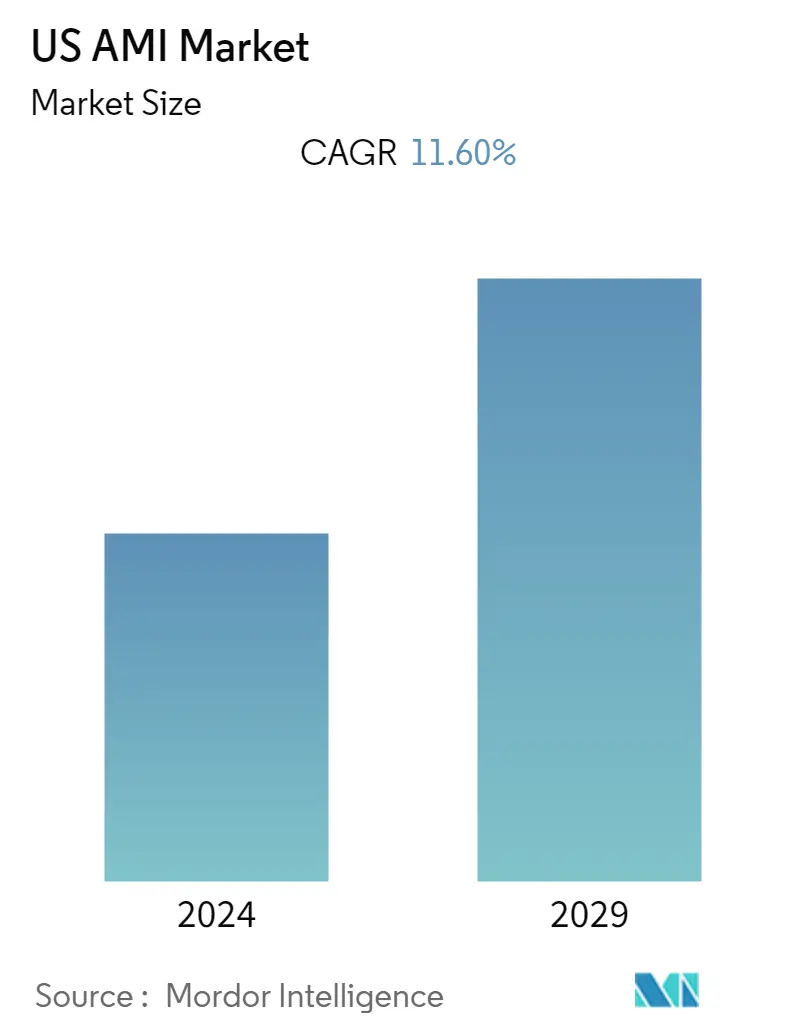
| Study Period | 2019 - 2029 |
| Base Year For Estimation | 2023 |
| Forecast Data Period | 2024 - 2029 |
| Historical Data Period | 2019 - 2022 |
| CAGR | 11.60 % |
| Market Concentration | Medium |
Major Players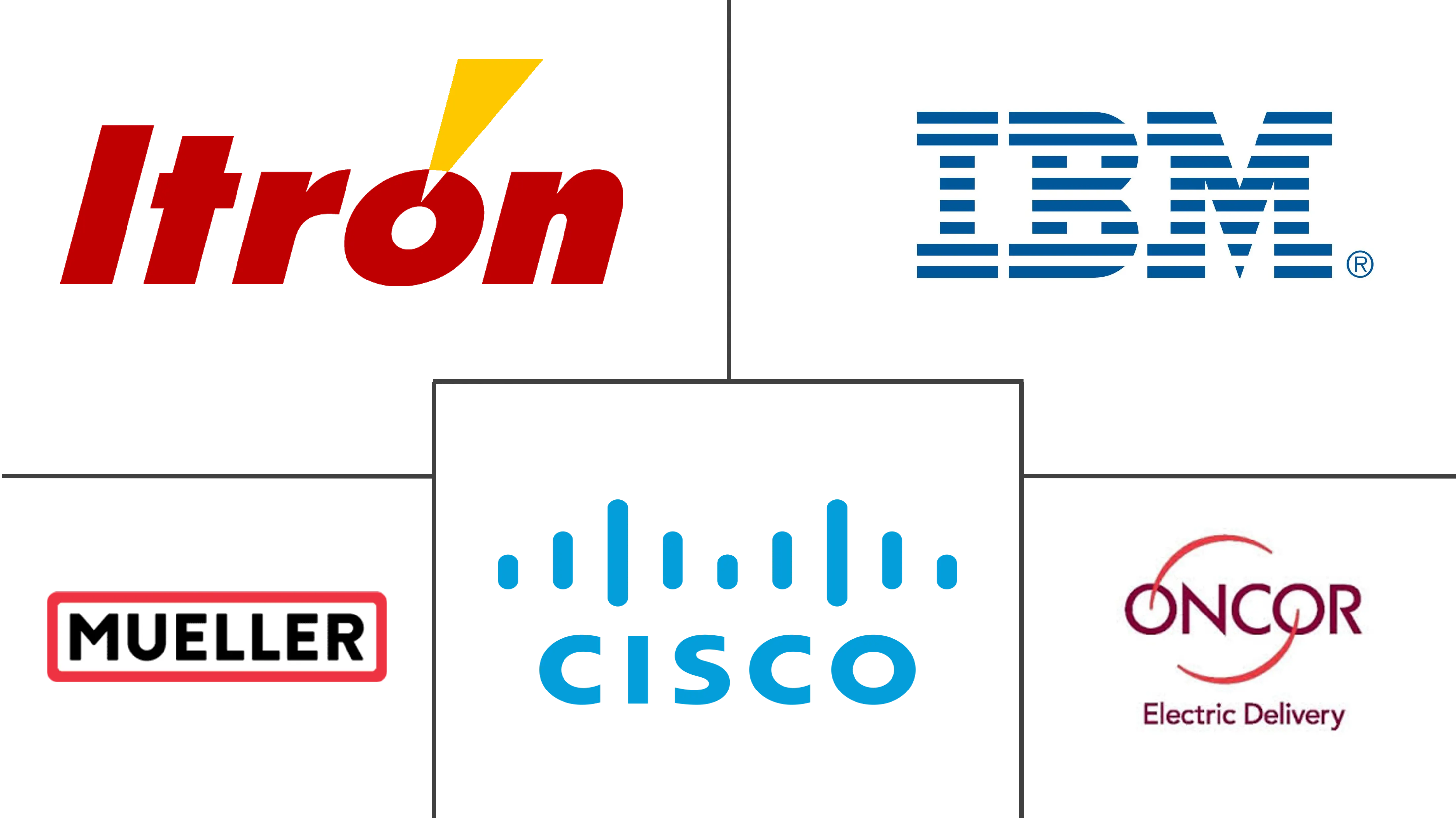
*Disclaimer: Major Players sorted in no particular order |
US Advanced Metering Infrastructure (AMI) Market Analysis
The United States Advanced Metering Infrastructure (AMI) Market is expected to register a CAGR of 11.6% during the forecast period. Smart Meters represent a transformative technology for the utility industry. These technologically advanced meters provide greater insight into the usage of energy. Smart Meters have been employed as a part of advanced metering infrastructure development initiatives worldwide.
- The development of an integrated, IT-enabled power grid and other pattern analysis support software benefits users greatly. This kind of grid, also known as a "smart grid," aids in increasing distributed production while lowering costs, fostering energy efficiency, and improving the overall security and dependability of the production, transmission, and distribution system. AMI must be used in all smart grid initiatives.
- The COVID-19 outbreak has boosted market growth because the energy and utility sectors provide critical services, forcing the industry to reconsider how it conducts business and interacts with both its employees and customers. However, as the pandemic impacted industrial and commercial work sites and altered load patterns, utilities' critical role in supplying energy to society changed.
- The United States is the region's key player, with the largest driver of the smart meters market, due to the American Recovery and Reinvestment Act (ARRA), which included funding for the Smart Grid Investment Grant (SGIG) program. The high demand for smart meters will drive the demand for the Advanced Metering Infrastructure market in the United States.
- The number of houses in the United States represents the potential market scope for utilities providing gas, and as new homes are built, sales of smart gas meters are expected to rise. Manufacturers of smart gas meters in the United States are hoping to capitalize on this opportunity as demand grows.
- As more new homes are built, an increasing proportion of them will have smart meters installed as part of AMI, extending its widespread adoption. According to the Institute for Electric Innovation, 107.0 million smart meters will be installed in the United States by the end of 2020. Furthermore, according to EEI, AMI will be available to nearly 70% of US customers by 2021.
- Furthermore, the American Recovery and Reinvestment Act (ARRA) funding for the Smart Grid Investment Grant (SGIG) program has bolstered the United States' advanced metering infrastructure. The widespread use of AMI in newly constructed homes is expected to fuel demand for smart meters in the country.
- However, Advanced Metering Infrastructure (AMI) project implementation success is far more difficult to achieve than technology success and should be the primary focus of any utility embarking on an AMI journey. Failure to meet schedule milestones, failure to meet utility expectations and requirements, poor coordination of necessary implementation tasks, and a lack of readiness to accept the organizational changes imposed by AMI systems are all common challenges for AMI projects.
US Advanced Metering Infrastructure (AMI) Market Trends
This section covers the major market trends shaping the US Advanced Metering Infrastructure (AMI) Market according to our research experts:
Smart Metering Devices will Command a Significant Market Share
- Smart metering solutions include meters or modules with communication capabilities (either unidirectional or bidirectional) embedded within or attached to the meter. Smart meters are becoming more popular due to the primary concern of increasing energy consumption, as they enable two-way communication between the meter and the central system used by utilities.
- Additionally, the digitalization of the electrical grid is already enhancing energy systems' efficiency, security, usability, and sustainability. For instance, using smart lighting and thermostats can reduce the overall energy use in commercial and residential buildings by 10% by 2040, according to an International Energy Agency (IEA) report. In addition, significant investments in digital electricity infrastructure open up market opportunities for smart meters in the United States.
- Smart meter deployment also enables implementing a Home Energy Management System (HEMS) or Building Energy Management System (BEMS) that allows visualization of the electric power usage in individual homes or entire buildings.
- Furthermore, various grid operators, as well as other gas and water utility providers, are effectively managing the demand for smart meters. Furthermore, smart city initiatives include the use of digital technologies for smart retail, IoT, smart mobility, and smart metering in order to create a sustainable city. Thus, such factors are expected to drive market growth.
- However, the high cost associated with smart meter installation borne by end users limits the market growth. Smart meters are an important component of smart city initiatives because they rely heavily on smart grid systems to ensure flexible distribution of electricity to power their various functions. Furthermore, a smart grid in a smart city enables renewable integration and clean energy production close to where it is needed, providing an opportunity for market growth.
- Also, targeted programs to the end-users are likely to benefit alongside leveraging smart electric meters for energy efficiency. For instance, Pacific Gas & Electric, in the United States, reported AMI targeting for a home retrofit program delivered 3.5 times more energy savings in the targeted homes. Additionally, the integration of smart electric meters with technologies such as data analytics is expected to further foster the growth of the market in the region.
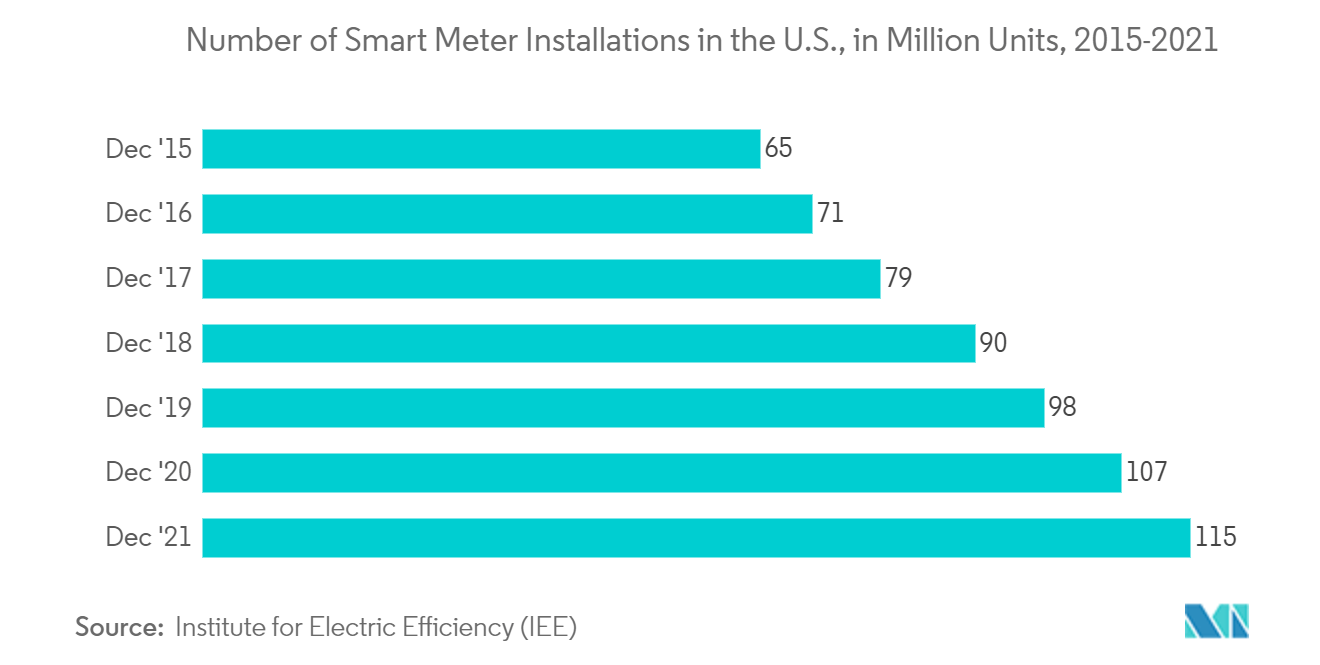
Shift Toward Energy Efficient/Saving Alternatives
- Advanced metering infrastructure is a technical solution to obsolete energy metering systems that improve energy efficiency by monitoring, storing, and transmitting real-time energy supply data from a business to a utility. Smart meters send digital data for utility services directly back to businesses for real-time monitoring and delivery data to the provider for resource management. Advanced metering technology can provide near-instant power, gas, and water outage alerts, as well as the amount of energy consumed and the associated cost of energy consumption across the United States.
- With easy-to-read screens that display real-time data for consumers and utilities to manage and monitor, smart energy meters keep track of the quality, quantity, and timing of energy use. Data is exchanged through secure wi-fi networks. Systems with smart meters can also provide analyses of the energy sources used, including the precise quantities of different energy sources used and calculated energy usage by particular appliances.
- Moreover, most utility companies in the United States will soon switch from traditional meters to smart meters. Utility companies and customers can offer lower prices during off-peak hours thanks to the detailed energy consumption data that smart energy meters give them.
- By significantly reducing the labor necessary to monitor energy use, smart meter technology saves utility money, enabling them to invest in smart grid development plans and other environmentally friendly technology. Smart meters eliminate anticipated bills by providing 100 percent accurate explanations of utility use, enabling businesses to better budget for utility costs.
- Moreover, The U.S. Energy Information Administration's (EIA) annual survey of electric power sales, revenue, and energy efficiency found that in 2020, 502 electric utilities had EE programs that contributed to an estimated decrease in total annual electricity consumption of about 28.2 billion kilowatt-hours (kWh). About 47% of the total annual electricity savings from utility EE programs in 2020 came from residential customers, and 44% came from commercial customers.
- Also, in September 2022, Saint-Gobain installed a smart water meter system and upgraded equipment at its siding plant in Social Circle, Georgia, US, reducing the site's water consumption by more than two million gallons per year. The project is part of Saint-Gobain's global Grow and Impact strategy, which includes ambitious environmental sustainability goals like reducing the company's consumption of water and other natural resources at its manufacturing sites.
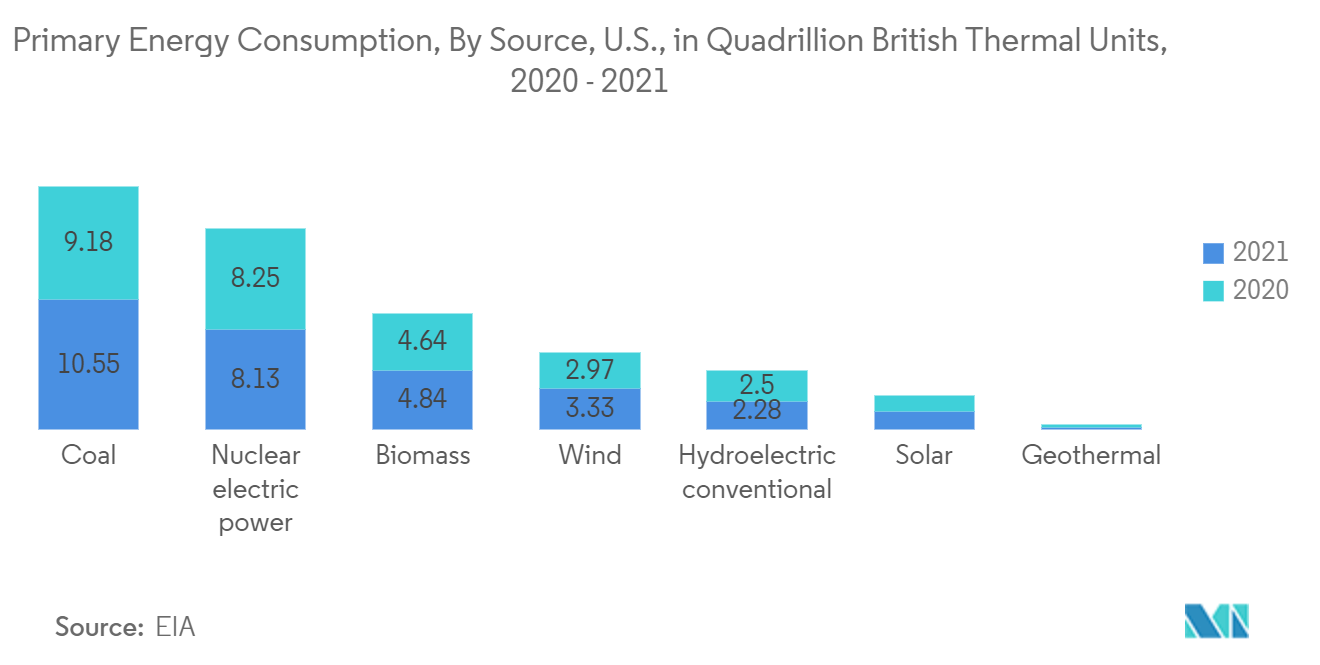
US Advanced Metering Infrastructure (AMI) Industry Overview
The United States advanced metering infrastructure market is moderately fragmented. The development of integrated and IT-enabled power grids and other support software to analyze the patterns, the increase in the use of smart meters, water metering solutions, and digitalization initiatives across the country provide lucrative opportunities in the United States.
- March 2022 - Itron and Utilismart announced they have begun offering a turnkey metering and data solution to smaller utilities in the United States for advanced metering infrastructure (AMI) rollout. The new service combines Utilismart's data and meter reading services with Itron's cellular meters to offer commercial and industrial customers interval consumption data, daily usage reports, and submetering solutions.
- August 2022 - The Texas city of Ovilla has chosen Smart Earth Technologies to supply advanced metering infrastructure. Because of SET's software leadership and a unique capability to deliver instant AMI without requiring creating and maintaining a proprietary network, the City's business case benefits are significantly accelerated.
US Advanced Metering Infrastructure (AMI) Market Leaders
-
Itron Inc.
-
IBM Corporation
-
Cisco Systems Inc.
-
Mueller Systems LLC
-
Oncor Electric Delivery Company LLC
*Disclaimer: Major Players sorted in no particular order
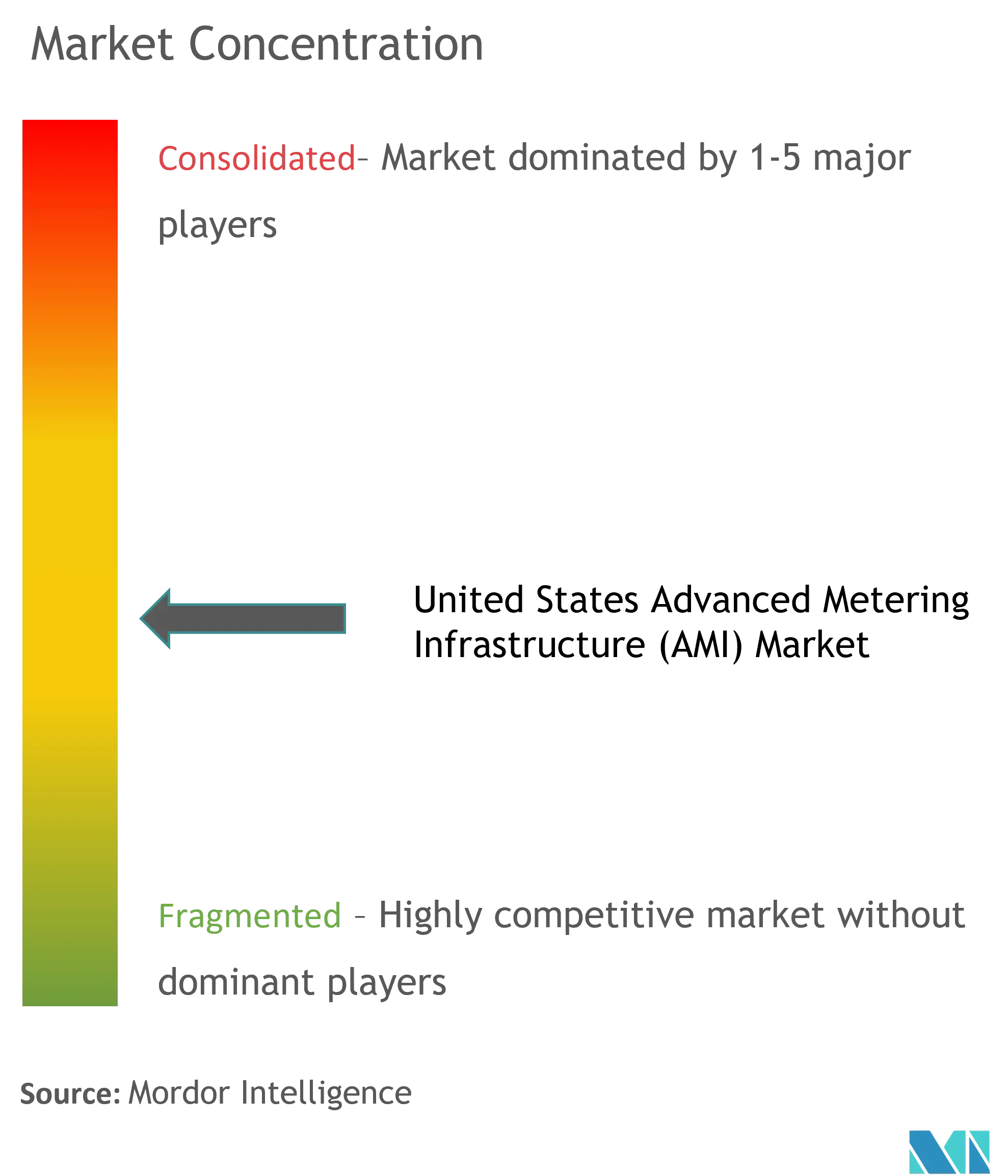
US Advanced Metering Infrastructure (AMI) Market News
- April 2022 - Otter Tail Power Company chose TRC Companies (TRC) to serve as a systems integrator for their advanced metering infrastructure (AMI) program. The project serves a large area in northwestern Minnesota, eastern North Dakota, and northeastern South Dakota. TRC will assist program management with system integration while collaborating with software and hardware providers across Otter Tail Power's AMI, meter data management (MDM), and customer information systems.
- April 2021 - According to Aclara Technologies LLC, US, Austin Utilities announced offering its electric, gas, and water customers an end-to-end advanced metering infrastructure solution based on the Aclara RF network. The manual meter-reading system is replaced by the point-to-multipoint AMI network, which supports 12,000 electric, 9,500 water, and 11,000 gas meters for the combined utility.
- March 2021 - Calaveras County Water District partnered with Mueller Systems to deploy an advanced metering infrastructure (AMI) network. It covers 1,000 square miles with 13,000 AMI endpoints. The project replaces most of the district's meters and adds communication capabilities to all meters. Calaveras County Water District provides water service to over 13,000 municipal, residential, and commercial customers in six service areas throughout the county.
US Advanced Metering Infrastructure (AMI) Market Report - Table of Contents
1. INTRODUCTION
- 1.1 Study Assumptions and Market Definition
- 1.2 Scope of the Study
2. RESEARCH METHODOLOGY
3. EXECUTIVE SUMMARY
4. MARKET INSIGHTS
- 4.1 Market Overview
- 4.2 Value Chain Analysis
-
4.3 Industry Attractiveness - Porter's Five Forces Analysis
- 4.3.1 Threat of New Entrants
- 4.3.2 Bargaining Power of Buyers
- 4.3.3 Bargaining Power of Suppliers
- 4.3.4 Threat of Substitute Products
- 4.3.5 Intensity of Competitive Rivalry
- 4.4 Impact of COVID-19 on the Market
5. MARKET DYNAMICS
-
5.1 Market Drivers
- 5.1.1 Shift Toward Energy Efficient Alternatives
- 5.1.2 Favorable Governmental Initiatives Driving Adoption Initiatives
-
5.2 Market Challenges
- 5.2.1 Integration Difficulties with Smart Meters
- 5.2.2 High Capital Investment for Infrastructure Installation and Lack of ROI
6. MARKET SEGMENTATION
-
6.1 Type
- 6.1.1 Smart Metering Devices (Electricity, Water, and Gas)
- 6.1.2 Solution
- 6.1.2.1 Meter Communication Infrastructure (Solution)
- 6.1.2.2 Software
- 6.1.2.2.1 Meter Data Management
- 6.1.2.2.2 Meter Data Analytics
- 6.1.2.2.3 Other Software Types
- 6.1.3 Services (Professional - Program Management, Deployment and Consulting and Managed)
-
6.2 End-user
- 6.2.1 Residential
- 6.2.2 Commercial
- 6.2.3 Industrial
7. COMPETITIVE LANDSCAPE
-
7.1 Company Profiles
- 7.1.1 Itron Inc.
- 7.1.2 IBM Corporation
- 7.1.3 Cisco Systems Inc.
- 7.1.4 Mueller Systems LLC
- 7.1.5 Oncor Electric Delivery Company LLC
- 7.1.6 General Electric
- 7.1.7 Honeywell International Inc.
- 7.1.8 Eaton Corporation
- 7.1.9 NuriFlex Inc.
- 7.1.10 Aclara Technologies LLC
- *List Not Exhaustive
8. INVESTMENT ANALYSIS
9. FUTURE MARKET OUTLOOK
** Subject To AvailablityUS Advanced Metering Infrastructure (AMI) Industry Segmentation
Advanced Metering Infrastructure (AMI) facilitates two-way communication and gives system operators an IT-enabled interface with consumers in both the residential and commercial sectors. Another key driver for adopting AMI and smart grid technology is reducing energy theft. The residential, commercial, and industrial sectors use AMI's various products and services, including smart meters, meter communication infrastructure, and data management.
The scope of the report covers various segments that are segmented by type (smart metering devices, solutions, services), and end-user (residential, commercial, industrial). The study also indicates the impact of COVID-19 on the United States' AMI market.
| Type | Smart Metering Devices (Electricity, Water, and Gas) | ||
| Solution | Meter Communication Infrastructure (Solution) | ||
| Software | Meter Data Management | ||
| Meter Data Analytics | |||
| Other Software Types | |||
| Services (Professional - Program Management, Deployment and Consulting and Managed) | |||
| End-user | Residential | ||
| Commercial | |||
| Industrial |
US Advanced Metering Infrastructure (AMI) Market Research FAQs
What is the current US AMI Market size?
The US AMI Market is projected to register a CAGR of 11.60% during the forecast period (2024-2029)
Who are the key players in US AMI Market?
Itron Inc., IBM Corporation, Cisco Systems Inc., Mueller Systems LLC and Oncor Electric Delivery Company LLC are the major companies operating in the US AMI Market.
What years does this US AMI Market cover?
The report covers the US AMI Market historical market size for years: 2019, 2020, 2021, 2022 and 2023. The report also forecasts the US AMI Market size for years: 2024, 2025, 2026, 2027, 2028 and 2029.
US AMI Industry Report
Statistics for the 2024 US AMI market share, size and revenue growth rate, created by Mordor Intelligence™ Industry Reports. US AMI analysis includes a market forecast outlook to 2029 and historical overview. Get a sample of this industry analysis as a free report PDF download.



